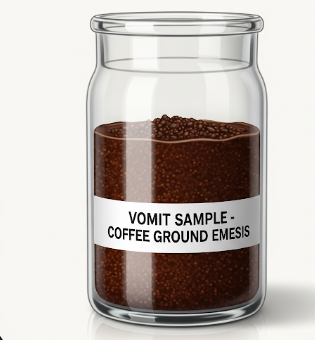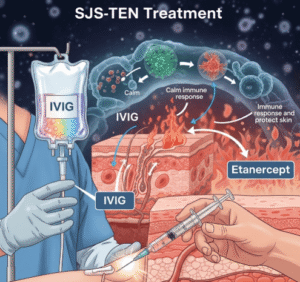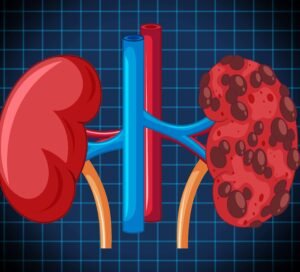Overview
Coffee ground emesis refers to vomiting material that looks dark brown or black, resembling coffee grounds. This condition usually indicates upper gastrointestinal (GI) bleeding, where blood in the stomach is partially digested by gastric acids.
In South Korea, gastroenterology and emergency care clinics provide advanced evaluation and treatment for coffee ground emesis. Using endoscopy, imaging, and laboratory tests, doctors can identify the bleeding source and provide effective interventions.
Key Facts
Highlights:
➡️ Coffee ground vomitus is always a warning sign of upper GI bleeding.
➡️ Common causes include peptic ulcers, gastritis, esophageal varices, or stomach cancer.
➡️ The vomitus appears dark brown and granular because the blood has been partially digested in the stomach.
➡️ Accompanying symptoms may include abdominal pain, dizziness, fatigue, or black/tarry stools (melena).
➡️ South Korea provides state-of-the-art gastroenterology care, emergency interventions, and endoscopic procedures for timely management.
What is Coffee Ground Emesis (Vomitus)?
Coffee ground emesis is vomit containing dark, granular material resembling coffee grounds, indicating bleeding in the upper GI tract (esophagus, stomach, or duodenum).
Key characteristics:
- Appearance: Dark brown or black, granular
- Consistency: Thick or partially clotted
- Associated Signs: Nausea, abdominal pain, dizziness, or weakness
- Medical Significance: Suggests active or recent GI bleeding, requiring prompt evaluation
This symptom is potentially serious and can signal conditions that may become life-threatening without proper treatment.
What Symptoms are Related to Coffee Ground Emesis?
Symptoms often accompanying coffee ground vomitus include:
- Abdominal pain or discomfort, especially in the upper abdomen
- Nausea and repeated vomiting
- Dizziness, lightheadedness, or fainting from blood loss
- Paleness or fatigue due to anemia
- Melena (black, tarry stools)
- Rapid heartbeat (tachycardia) or low blood pressure in severe bleeding cases
Highlights:
➡️ Coffee ground vomitus combined with melena indicates significant upper GI bleeding.
➡️ Persistent vomiting or signs of shock requires immediate emergency attention.
➡️ Early recognition can save lives and prevent severe complications.
What Causes / Possible Causes of Coffee Ground Emesis?
Highlights:
➡️ Peptic Ulcers: Ulcers in the stomach or duodenum erode blood vessels, causing bleeding.
➡️ Gastritis: Severe inflammation of the stomach lining may lead to bleeding.
➡️ Esophageal Varices: Dilated veins in the esophagus, often due to liver cirrhosis, may rupture.
➡️ Mallory-Weiss Tear: Small tear in the esophagus due to forceful vomiting.
➡️ Stomach Cancer: Tumors may bleed and cause coffee ground vomitus.
➡️ Medication-Induced: NSAIDs, aspirin, or anticoagulants increase bleeding risk.
➡️ Mechanism: Blood in the upper GI tract is partially digested by stomach acid, turning it dark brown and granular, resembling coffee grounds.
When Should I See My Doctor?
Highlights:
➡️ Immediate medical attention is required if vomiting coffee ground material, as it indicates GI bleeding.
➡️ If accompanied by dizziness, fainting, rapid heartbeat, or low blood pressure, go to the emergency room.
➡️ Persistent upper abdominal pain or repeated vomiting warrants urgent evaluation.
➡️ For patients with known ulcers, liver disease, or on blood-thinning medication, early consultation is critical.
➡️ Prompt evaluation ensures rapid diagnosis, bleeding control, and prevention of life-threatening complications.
Care and Treatment
Treatment depends on the cause, severity, and overall health of the patient:
Highlights:
➡️ Stabilization:
- Intravenous (IV) fluids to maintain blood pressure
- Blood transfusions if significant blood loss occurs
➡️ Medications:
- Proton pump inhibitors (PPIs) to reduce stomach acid
- Antibiotics for Helicobacter pylori infection if present
- Medication review to stop or adjust drugs that increase bleeding risk
➡️ Endoscopic Treatment:
- Emergency endoscopy to identify bleeding source
- Therapeutic interventions: clipping, cauterization, or injection to stop bleeding
➡️ Surgical Intervention:
- Rarely required but may be necessary for uncontrolled bleeding or perforated ulcers
➡️ Lifestyle Measures:
- Avoid NSAIDs or alcohol until cleared by a doctor
- Follow a bland diet during recovery
- Regular follow-up to prevent recurrence
➡️ Monitoring: Continuous observation for vital signs, hemoglobin levels, and recurrence of vomiting.
Treatment Options in Korea
South Korea provides advanced care for coffee ground emesis, including:
Highlights:
➡️ Gastroenterology Clinics: Prompt diagnosis using endoscopy, imaging, and lab tests.
➡️ Emergency Care: Rapid stabilization for patients presenting with active bleeding or shock.
➡️ Endoscopic Therapy: Immediate treatment of bleeding ulcers, varices, or tears.
➡️ Multidisciplinary Approach: Gastroenterologists, surgeons, and ICU specialists collaborate for optimal patient outcomes.
➡️ Medical Tourism Support: Multilingual consultations, advanced diagnostics, and coordinated treatment for international patients.
➡️ Preventive Care: Follow-up endoscopy, lifestyle guidance, and eradication of H. pylori to prevent recurrence.













